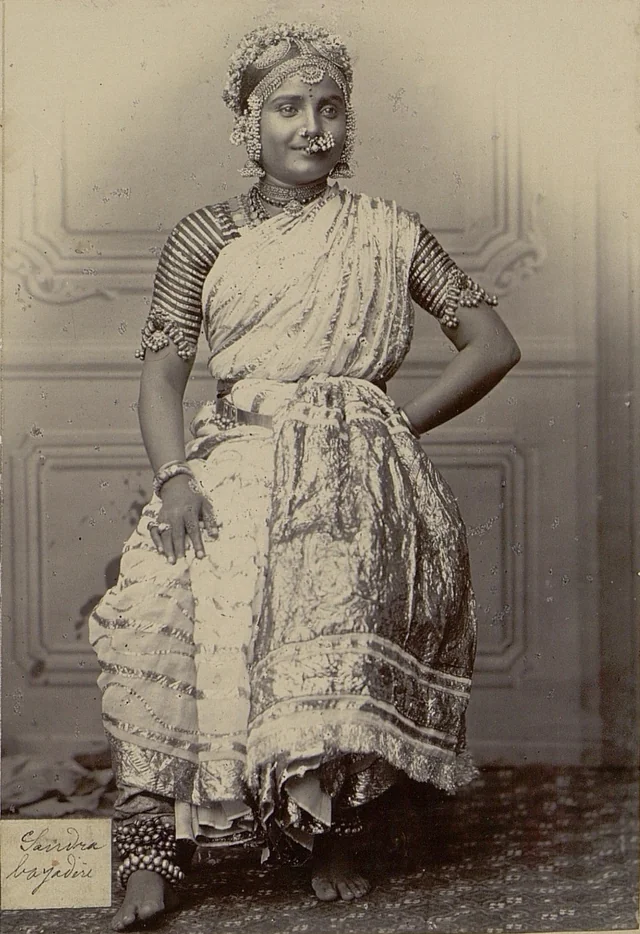Indian classical dances such as Bharatanatyam, Kuchipudi, and Odissi are celebrated as timeless embodiments of India’s cultural heritage. Yet, their modern practice reveals a complex history of caste, colonialism, and cultural appropriation that has sidelined the very communities who birthed these art forms. Once performed by lower-caste women like Devadasis and Maharis, these dances are now largely dominated by upper-caste Hindus, particularly Brahmins. This shift, rooted in colonial suppression and 20th-century revivalism, underscores a troubling erasure of marginalized voices in India’s artistic legacy.
 | |
| Devadasi named Gnyana of Tanjore, 19th century. She also performed at the Royapuram Station Hall at the reception held for the Prince of Wales in 1875. |
Historical Roots in Marginalized Communities
Indian classical dances have deep origins in the traditions of Devadasis (in Tamil Nadu), Maharis (in Odisha), and Nautch girls, among others. These women, often from Dalit or Other Backward Classes (OBC) communities, were highly skilled in music, dance, and temple rituals. Their performances in temples and royal courts were not only artistic but also held spiritual and cultural significance. Far from the stigmatized perception they face today, Devadasis and their counterparts were once respected as custodians of sophisticated artistic traditions.
However, their caste and gender made them vulnerable to exploitation. While their roles were prestigious in certain contexts, their association with temple and courtesan traditions often placed them on society’s margins, a dynamic that would later be weaponized against them.
Colonial Suppression and Stigma
The arrival of British colonial rule in the 18th and 19th centuries marked a turning point. Through a Victorian moral lens, the British branded Devadasis and similar performers as “prostitutes,” condemning their practices as immoral. Colonial policies eroded the socio-economic systems that supported these women, dismantling their roles in temples and courts. The Devadasi Abolition Act of 1947 (and subsequent amendments) formalized this suppression, outlawing their temple performances and further stigmatizing their communities. As a result, their art forms—intricately tied to their caste, gender, and perceived sexuality—were shunned, leaving a cultural vacuum.
The Brahminical Revival: Sanitization and Appropriation
In the early 20th century, a movement to “revive” Indian classical dance emerged as part of a broader nationalist effort to reclaim cultural heritage. Figures like Rukmini Devi Arundale, a Brahmin and founder of Kalakshetra, played a pivotal role in reshaping Bharatanatyam. This revival, however, came at a cost. The dance was stripped of its erotic and folk elements, reframed as a “spiritual” and “respectable” art form suitable for urban elites and global audiences. By moving performances from temples and courtesan spaces to proscenium stages and formal institutions, the art was “sanitized” to align with upper-caste sensibilities.
This process effectively excluded the original practitioners. Upper-caste families, particularly Brahmins, began learning and teaching these dances, establishing themselves as the new custodians. State-funded academies, cultural sabhas, and dance schools—often controlled by upper-caste networks—further entrenched this shift, sidelining Devadasi descendants and other marginalized communities.
Why Upper-Caste Dominance Persists
Today, the ecosystem of Indian classical dance remains predominantly upper-caste, especially Brahmin-dominated, for several reasons:
- Access and Privilege: Upper-caste families often have the financial resources, leisure time, and social networks to pursue and promote classical dance. Training, costumes, and performance opportunities require significant investment, which excludes many from marginalized backgrounds.
- Cultural Gatekeeping: The guru-shishya (teacher-student) tradition, concert halls (sabhas), and institutional frameworks are largely controlled by upper-caste practitioners. These gatekeepers often dictate who can access training and performance spaces, marginalizing lower-caste artists.
- Persistent Stigma: Descendants of Devadasi and similar communities face ongoing social and economic stigma, which discourages their participation in the “respectable” world of classical dance. Their historical association with sensuality and caste-based prejudice further alienates them.
- Erasure in Education: The curricula and syllabi of dance institutions rarely acknowledge the contributions of Devadasis or other marginalized groups. The “classical” label, with its emphasis on purity and tradition, obscures the dances’ roots in lower-caste and folk traditions.
The Irony of “Classical” Dance
The irony is stark: the women whose traditions formed the backbone of Indian classical dance are now largely excluded from its practice and recognition. The “classicization” of these art forms has erased their complex histories of caste, gender, and sexuality, presenting a sanitized version that aligns with upper-caste values. This appropriation not only marginalizes Devadasi descendants but also distorts the rich, diverse origins of these dances.
Resistance and Reclamation
In recent years, a growing movement has sought to address this injustice. Dalit and Bahujan artists, alongside scholars like Saskia Kersenboom, Vijaya Ramaswamy, and Davesh Soneji, have worked to document the contributions of marginalized communities and challenge casteism in the arts. Their efforts highlight the need for inclusive dance education and caste-aware pedagogy. Grassroots initiatives are slowly creating space for lower-caste artists to reclaim their heritage, though systemic barriers remain formidable.
Moving Forward
The dominance of upper-caste Hindus in Indian classical dance is a legacy of colonial disruption and Brahminical appropriation, but it is not an immutable reality. Acknowledging the contributions of Devadasis, Maharis, and other marginalized women is a critical first step. Institutions must prioritize inclusive access, diversify their leadership, and integrate honest historical narratives into their curricula. Only then can Indian classical dance truly reflect the richness of its origins—a vibrant tapestry woven by artists of all castes and backgrounds.
By confronting its casteist past and present, the world of Indian classical dance can honor its true custodians and reclaim its place as a universal art form, rooted in resilience, creativity, and diversity.